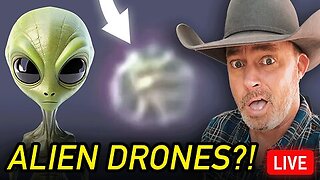Premium Only Content

Venus Flytrap Eats Wasps
Occurred on July 20, 2023 / Dohr, Germany
Info from Licensor: "An encounter with the Venus flytrap My name is Lothar Lenz and I work as a nature filmmaker and nature photographer mostly in my home region, the Eifel in Germany. I have captured countless moments in nature, but the day I was allowed to film the Venus flytrap on its hunt is one of the most fascinating. The Dionaea muscipula, as it is scientifically known, is not only a technical masterpiece of evolution, but also a plant that casts a spell over the observer.
I was standing in my garden early in the morning waiting for the wasps that attract my attention every summer. Their natural home is in the Carolina bogs, but these interesting plants have been cultivated by enthusiasts all over the world for many decades. I too have a planter of carnivorous plants in my garden.
To attract the social wrinkle wasps, I run feeding stations where they can ingest energy-rich sugary solutions. I had a mishap this morning when applying these solutions, I sprayed some of it and a few drops landed on the catch leaves of the wasp fly traps.
And there they were very quickly discovered by the wasps, which then sucked up the treats right there.
The Venus flytrap is a carnivorous plant, a deadly beauty that thrives mainly in nutrient-poor soils. To meet its need for nitrogen and other nutrients, it has developed a highly specialized trapping device. This consists of modified leaves that are covered with tooth-like bristles on their edges. The insides of these leaves are often colored red, which attracts insects.
The fine trigger hairs on the surface of the trap are essential for its function. When an insect enters the trap and touches one of these hairs, an electrical signal is triggered. However, the plant does not close immediately - it waits for a second touch within about 20 seconds. This double signal ensures that the trap is not accidentally triggered by raindrops or other debris.
The moment the second touch is made, the trap snaps shut - in less than a second! The bristles on the edges close like bars so that the victim cannot escape. The plant then begins to produce digestive enzymes that slowly decompose the insect. The nutrients released are absorbed by the plant, while the indigestible remains fall out of the trap after a few days when it opens again.
When I saw that the wasps had landed there, my interest was immediately aroused, I positioned the camera with the macro lens and filmed the fascinating event. The wasps scurried back and forth teasingly, one of them touched a first trigger hair. Nothing happened. They moved on, searching for the nectar and finally touched a second hair.
At that moment it happened: the trap closed in a flash. I was able to capture the process with my macro lens. The bristles of the trap intertwined and the wasp wriggled desperately in its prison. Within a few hours, the plant began to secrete the digestive fluid. It was an amazing insight into the power and precision of this plant.
Not all capture attempts were successful, many wasps were able to free themselves and escape.
The Venus flytrap specializes in extremely poor soils that contain little nitrogen. Its strategy of catching insects enables it to survive in habitats where other plants cannot thrive. In addition to insects, it occasionally feeds on spiders and other small invertebrates. Interestingly, the plant only closes its trap completely if the captured object is sufficiently large and nutritious. Small prey that would provide too few nutrients are often released again.
The Venus flytrap is also an example of the fragility of ecosystems. Their habitats in the south-eastern USA are threatened by human intervention. Their ability to obtain nutrients from insects does not protect them from the dangers of deforestation and wetland drainage.
The moment I saw the Venus flytrap in action was also a reminder to me of how amazing and adaptable life on Earth can be. The precision and efficiency with which this plant catches its prey is a miracle of evolution. And as I packed up my camera, I was grateful to have witnessed such a special moment."
-
 2:37
2:37
Canadian Crooner
1 year agoPat Coolen | Let It Snow!
11K8 -
 2:44
2:44
BIG NEM
9 hours agoWhat's Really Behind the Fake Alpha Male Epidemic?
12.7K4 -
 57:20
57:20
State of the Second Podcast
7 days agoThe Inventor of Bump Stock Fights Back! (ft. Slide Fire)
8.6K3 -
 1:04:12
1:04:12
PMG
1 day ago $8.13 earned"I’ll be DRONED for Christmas!"
21K6 -
 23:38
23:38
RealitySurvival
1 day agoBest Anti-Drone Rounds For Self Defense
13.6K2 -
 57:43
57:43
barstoolsports
16 hours agoBest Shot Wins The Game | Surviving Barstool S4 Ep. 7
204K9 -
 1:52:24
1:52:24
Kim Iversen
12 hours agoLuigi Mangione Charged With TERRORISM | Liz Cheney Accused Of WITNESS TAMPERING, Faces 20 YEARS IN JAIL
110K146 -
 6:50:10
6:50:10
Akademiks
13 hours agoJay Z says he aint NEVER been friends w/ DIDDY! Bhad Bhabie lost her man? Travis Hunter Down Bad?
114K14 -
 2:27:04
2:27:04
AirCondaTv Gaming
11 hours ago $24.12 earnedWar Thunder - Tankering Around for That 10 Bomb
58.4K5 -
 4:19:05
4:19:05
SpartakusLIVE
14 hours agoThe MACHINE locks in for 12-hour POWER stream
41.2K1